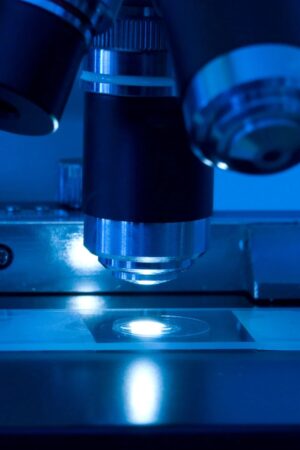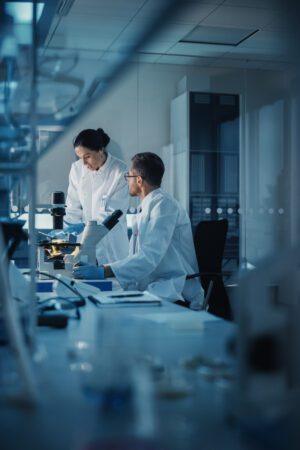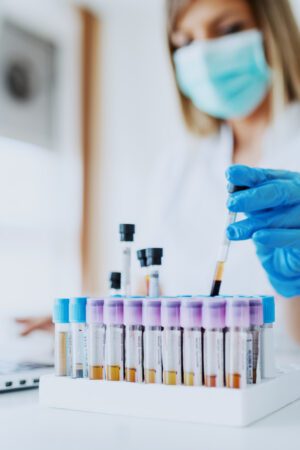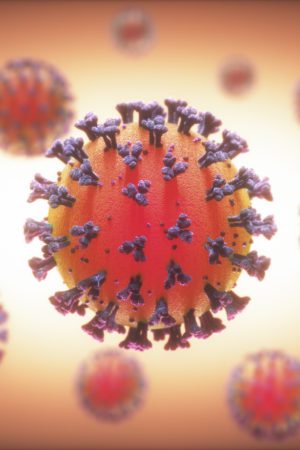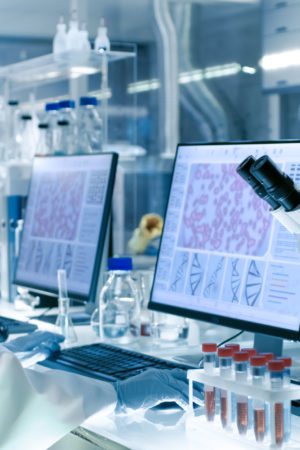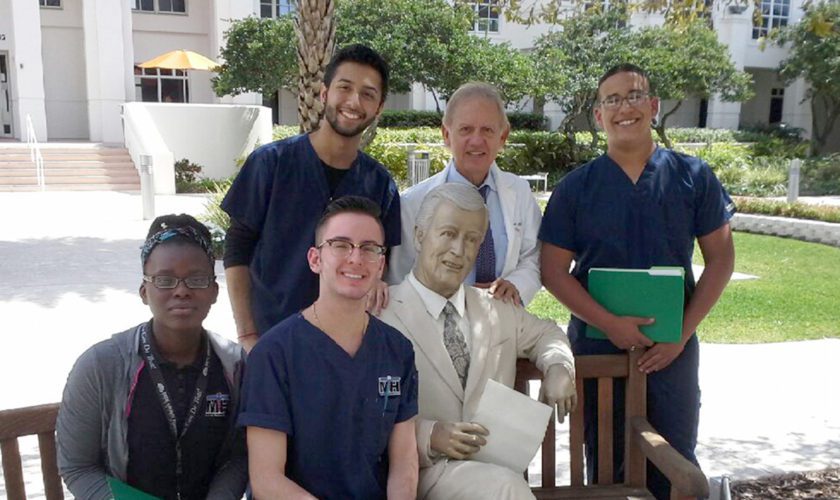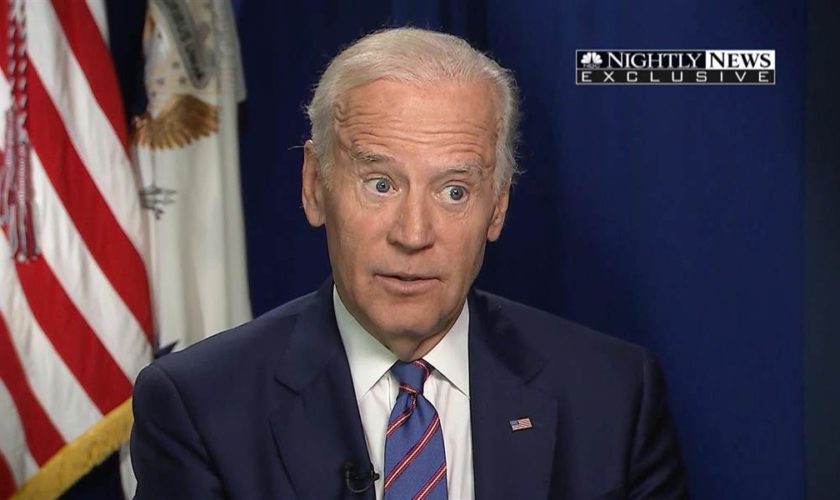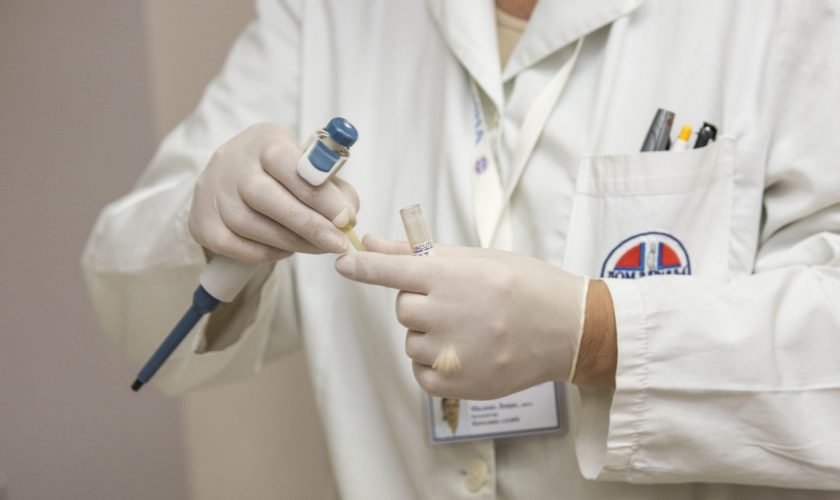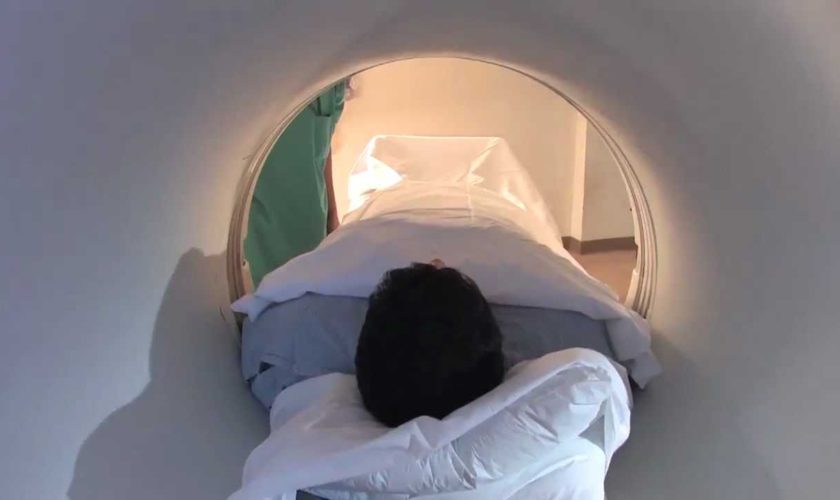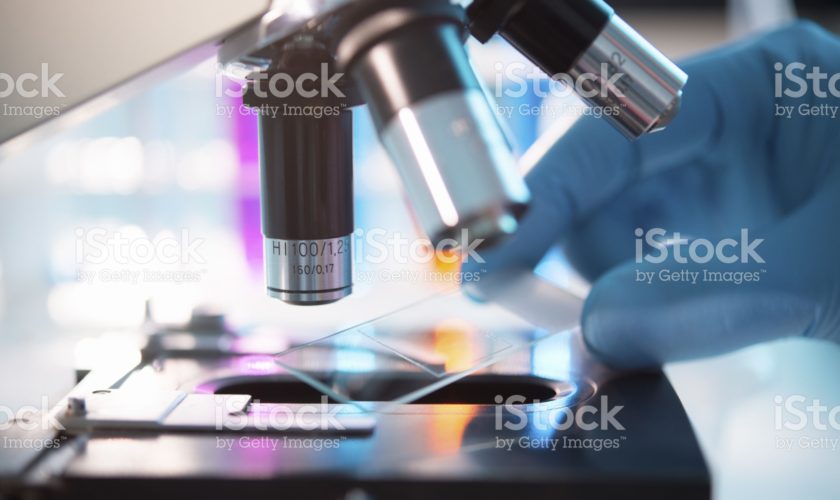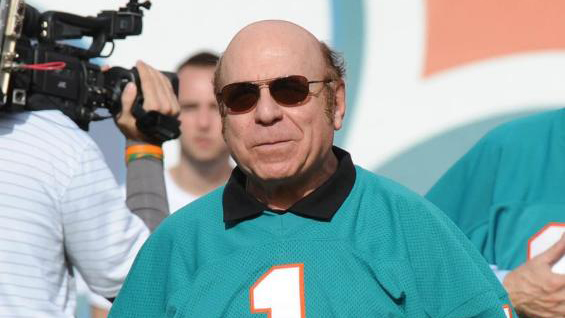Lampidis News
Students at the renowned Medical Academy for Science and Technology (MAST Academy), a secondary magnet high school located in Homestead, Florida, have recently launched a campaign to support the goal of the Lampidis Cancer Foundation to raise funds and awareness for 2-DG research and help develop a universal cure for cancer.
2-DG is the focus of Dr. Theodore Lampidis’ groundbreaking cancer research at the University of Miami. He discovered that those cancer cells within a tumor that are resistant to standard chemotherapy can be effectively targeted and killed by using 2-DG, a simple analog of glucose. Furthermore, Dr. Lampidis has recently found that by combining 2-DG with fenofibrate, a commonly used cholesterol medication, the entire tumor can be killed without the need for toxic chemotherapy.
Even though Dr. Lampidis’ work has recently received Congressional recognition, 2-DG cannot be patented, so pharmaceutical companies are not interested in funding research that they can’t make money from. And federal funding for cancer research has suffered a sharp decline in recent years.
Max Losner, Senior Class President at MAST, commented: “MAST students represent the future of scientific research and discovery. It’s up to us to step in where industry is failing, and raise the flag for viable cancer treatments like 2-DG. We plan to spread the word through social media, and encourage other students at schools and universities to join our cause.”
“We are delighted and honored to have the recognition and support of the very talented students at MAST @ Homestead,” said Dr. Lampidis, after giving a lecture on the fundamentals of 2-DG to the students. “Their enthusiasm is infectious, and the Students for 2-DG! initiative will undoubtedly make a significant impact in our fight to bring this universal cancer treatment to benefit patients worldwide.”
Follow us at: @Studentsfor2DG
RE: Project Moonshot – Developing a Universal Cure for Cancer Using 2-DG
March 8, 2016
Dear Vice President Biden,
Allow me to first express how sorry I was to hear about the untimely death of your son Beau from cancer. Please accept my sincere condolences. We have all lost too many family members and friends to this devastating disease, and finding a cure must become a global priority.
I was immensely encouraged to read your recent, timely announcement regarding Project Moonshot, and your call to arms to the global scientific community to accelerate the search for a cure for cancer. This is something that I have devoted my professional life to, and am writing to ask for your assistance to provide the final breakthrough.
Our laboratory has gained international recognition and leadership in the exploitation of increased glucose metabolism in cancer cells using the sugar analog 2-deoxy-D-glucose (better known as 2-DG) as a universal treatment for cancer. Until three years ago, our work had received almost continuous funding in the form of grants from the National Cancer Institute, who themselves have stated in their reviews of our lab’s research that “Dr Lampidis’ work could eventually lead to cures in certain cancers.”
I, as well as a growing number of research scientists and physicians from the global community (many of whom have endorsed this letter) believe that the biochemical principles supporting 2-DG as a universal treatment for cancer are as fundamental as the physical laws governing gravity.
The following brief paragraph will explain why.
Molecular biology has demonstrated that all the major genes (oncogenes) responsible for driving cancer also have a pathway by which they increase glucose uptake within all tumor cells regardless of their origin. These findings support and explain results from millions of PET scans demonstrating that glucose is taken up more by tumors than normal tissues. Our discovery is based on the fact that the cancer cells most resistant to chemotherapy found within the inner core of all solid tumors do not receive enough oxygen, and therefore must rely exclusively on sugar to survive. Feeding these hypoxic tumor cells a false sugar such as 2-DG effectively ‘starves’ them to death. We have proven this time and again in in vitro and in vivo studies.
Unfortunately, despite a very promising and successful Phase I clinical trial, we have hit a major roadblock in our funding. The sad reality is that given the non-patentable nature of 2-DG and the resulting dis-incentive to the pharmaceutical industry, not to mention politics and conflicts of interest within grant setting bodies, our funding has dried up. Thus, we have had to resort to philanthropy and the tireless work of volunteers to raise awareness of our cause of bringing this universal cancer treatment through the remaining phases of clinical trials to make it available to patients. It will take the vision and support of individuals in positions of authority to achieve that. I believe that you are ideally positioned to lead the way and champion a cause that will benefit mankind immeasurably.
Three weeks ago, a review article titled “Energy disruptors: rising stars in anticancer therapy” was published in a Nature sponsored journal citing our work and extolling the virtues of 2-DG as an anticancer agent. The authors conclude their discussion of 2-DG questioning: why are there no further clinical trials at NIH with 2-DG? This unsolicited and non-biased endorsement adds to the growing interest in the scientific community in 2-DG as a universal treatment for cancer.
I have attached a link to a review paper we published last year titled, “The Wonders of 2-DG” which explains the science in more detail.
I would welcome an opportunity to meet with you and your team to discuss the importance of this work and the urgent need for your assistance to ensure that this viable cure for cancer is not overlooked.
Yours sincerely,
Theodore J. Lampidis, Ph.D.
The following have endorsed this letter:
Timothy G. Murray, MD MBA FACS, Founding Director, Miami Ocular Oncology and Retina (MOOR) Miami, FL; Metin Kurtoglu, MD, PhD Medical Oncologist, Koç University, Istanbul, Turkey. Mark A. Lehrman, PhD Professor of Pharmacology, UT-Southwestern Medical Center, Dallas, TX. Luis E. Raez MD FACP FCCP, Chief Hematology/Oncology & Medical Director, Memorial Cancer Institute, Hollywood, FL. Frederic Bost, PhD, Research Director, INSERM U1065, C3M 151 Route de St Antoine de Ginestière, Nice, France. Jiyong Liang, MD, PhD, Assistant Professor, Systems Biology, The University of Texas MD Anderson Cancer Center, 1515 Holcombe Houston, TX. Bilikere S Dwarakanath, PhD, Professor, Sri Ramachandra University, Chennai, India. Javier Cortes MD PhD, Head, Breast Cancer and Gyn Tumors, Ramon y Cajal University Hospital, Madrid, Spain; Investigator, Vall d´Hebron Institute of Oncology (VHIO), Barcelona, Spain. Steven J. Melnick, Ph.D., M.D., Chief, Department of Pathology and Clinical Laboratories, Nicklaus Children’s Hospital, Miami, FL. Jean-Ehrland Ricci, PhD, Research Director, INSERM U1065, C3M, 151 Route de St Antoine de Ginestière Nice, France. Guillermo DeAngulo, MD, Associate Professor, Herbert Wertheim College of Medicine, Nicklaus Children’s Hospital, Miami, FL. Branko Cuglievan MD, Pediatric Oncology fellow, MD Anderson Cancer Center, Houston, TX. Cristina Munoz-Pinedo, PhD, Group Leader – Oncology Program, Bellvitge Biomedical Research Institute (IDIBELL), Barcelona, Spain. Steven Vanni, DO, DC, Neurosurgeon, University of Miami, Miller School of Medicine, Associate Professor of Clinical Neurological Surgery, Orthopaedics and Rehabilitation Miami, FL. Katherine B. Philips, PhD, Health Care Education Manager, American Society of Clinical Oncology, Alexandria, VA. Jonathan C. Maher, PhD, Scientific Director, Biopharmaceutical Professional, Chicago, IL. Keith Webster, PhD, Professor, Department of Molecular and Cellular Pharmacology, Director, Vascular Biology Institute, University of Miami, Miller School of Medicine, Miami, FL. Guy J. Leclerc, PhD, Assistant Professor, University of Miami, Miller School of Medicine, Department of Pediatrics, Division of Pediatric Hematology/Oncology, Miami, FL. Regina M. Graham, PhD, Research Assistant Professor, Director UMBTI Research Laboratory, Department of Neurosurgery, University of Miami, Miller School of Medicine, Miami, FL. Gilles M. Leclerc, PhD, Assistant Professor, University of Miami, Miller School of Medicine, Department of Pediatrics, Division of Pediatric Hematology/Oncology, Miami, FL. Cheppail Ramachandran, PhD, MBA, Sr. Research Scientist, Department of Pathology, Nicklaus Children’s Hospital, Miami, FL. Medhi Wangpaichitr, PhD, Research Scientist, Miami VA Healthcare System, Miami, FL. Mitchel A. Gregg, MD, Diplomat, American Boards of Radiology & Nuclear Medicine, Chief of Radiology, Gastro Health, Miami, FL. Daniel James Snyder, FACHE, CEO, Asia Pacific Partners, Mumbai, India. Leyan Phillips, Executive Director, Lampidis Cancer Foundation, Miami, FL.
Photography courtesy of NBC Nightly News
As we embark on another year where cancer is expected to surpass heart disease as the number one death-causing disease in numerous states in America including Florida, it becomes imperative to find more effective and less toxic treatments. Just last week, President Obama designated Vice President Biden to spearhead “Moonshot” – yet another program dedicated to curing cancer.
It is difficult to believe and accept that the sugar analog 2-deoxy-D-glucose, better known as 2-DG, still is not approved for clinical use. We and many others have shown 2-DG to be much less toxic than standard chemotherapy, and have proven it to be more effective against a broader range of tumors than any other known treatment. We have set the clinical groundwork for 2-DG to help cancer patients by successfully completing an FDA-approved Phase I Clinical Trial, but without further pre-clinical work to bring it through the required subsequent trials it will remain stalled in development.
Last year, several laboratories reported on the unique effectiveness of 2-DG in cancers where it has not been tried before. A recent example is a report titled Antileukemic Activity of 2-Deoxy-d-Glucose Through Inhibition of N-Linked Glycosylation in Acute Myeloid Leukemia with FLT3-ITD or c-KIT Mutations (published in Molecular Cancer Therapeutics, October 6, 2015). AML is a particularly deadly form of leukemia that not only affects adults but now has become the second most common cancer in children.
In collaboration with three other labs this past year alone, we have reported on the effectiveness of 2-DG in Acute Lymphoblastic Leukemia (ALL) as well as rhabdomyosarcomas – both cancers that afflict children as well as adults. Moreover, in addition to its direct effect on these types of tumor cells, we have shown that 2-DG also acts as an anti-angiogenic drug – shutting down the blood supply required for a tumor to grow and survive
The evidence for using 2-DG to treat cancer is growing year by year. And yet it remains mired in academic medicine. 2-DG can’t be patented. Therefore pharma companies can’t make money out of it. No profit means no interest from industry. The only barrier preventing 2-DG from progressing through the next phase of clinical trials is funding. That’s why we are relying on the general public to bring this pioneering treatment protocol to patients.
Learn more or donate now at lampidisfoundation.org.
It’s really very simple. The high rate of mutation giving rise to too many different types of cancer cells in a growing tumor has made it nearly impossible for so-called “tailored” or “targeted” therapy to succeed. Billions of dollars have been spent so far using this approach with modest to little benefit to most cancer patients treated.
So why not come up with a new strategy that is based on a more rational approach?
For more than 30 years the results from literally millions of PET scans has shown us that tumors take up more glucose than normal surrounding tissues. But only more recently has the reason for this increased glucose uptake in tumors become known.
Surprisingly, or perhaps not so surprisingly when one thinks about it, the same genes that are driving cancer (oncogenes) have been found to be responsible for directing a cancer cell to take up more glucose.
Using sophisticated techniques such as NMR and Mass Spec it has been shown that the glucose molecule is not only a vital energy source but provides the building blocks required for a cell to replicate.
Thus, increased glucose metabolism is the universal trait that investigators have long been seeking in their quest to find a feature common to all cancer cells regardless of their tissue origin or genetic (oncogene) profile.
Our approach, therefore, using the analog of glucose, 2-deoxy-D-glucose , better known as 2-DG, takes advantage of this natural window of selectivity that increased glucose uptake provides in cancer vs. normal cells.
We have provided proof of principle that 2-DG works in many different tumor cell types when grown in the lab in vitro (in dishes) and have advanced our ideas in vivo (in tumor animal models). Our results have taken 2-DG all the way up to and including completion of an FDA-approved Phase I human clinical trial.
So why isn’t this universal treatment for cancer not already helping cancer patients suffering from this devastating disease world-wide?
There are many answers to that question, but the major obstacle that has slowed the development of 2-DG is that it is not patentable.
Therefore, the pharmaceutical industry is not interested in providing the financial resources required to put it through the next phase of clinical trials needed to make 2-DG a frontline treatment.
Other obstacles, less obvious but perhaps equally important, preventing 2-DG from reaching patients are the unwillingness of those in control of funds to devote the resources to treatments that they are either not part of or, for personal or political reasons, are against.
Although our lab and this work has attracted and been awarded National Institutes of Health Grants for more than 20 years, the funding from these sources is dwindling and we have therefore turned to philanthropy to get us to the next step. So please take a moment to explore our website further to learn more about our work and to see why we are asking you to join us in helping bring this universal treatment to benefit cancer patients world-wide.
A new paper by a well-respected research scientist has just been published today in an equally well-respected journal (PLoS ONE), adding to the overwhelming case for 2-DG to be used as a universal treatment for cancer. In this article, the investigators demonstrate that by delivering 2-DG chronically in the diet, a lethal form of cancer, Ehrlich’s Ascites tumor, can be inhibited in mice.
There is now more than enough third-party evidence to back up the results from the Lampidis Lab, which itself has more than 30 peer-reviewed publications on the mechanisms by which 2-DG exerts its remarkably selective effects on a wide variety of cancer types. We are confident that we are indeed on the right track, and must redouble our efforts to overcome the obstacles of enabling 2-DG to be used to treat cancer patients world-wide.
It has become quite clear that because 2-DG has such widespread application in so many different cancer types, regardless of their tissue of origin as well as their oncogenic profile, the pharmaceutical industry is not interested in seeing this universal cancer treatment progress from the Phase I human clinical trials we have been through. Unfortunately, since no-one owns the compositional patent rights to this drug, there is little monetary incentive for the pharmaceutical industry to provide the financial resources required to bring 2-DG through the next phases of human trials to make it available as a frontline anti-cancer agent.
I firmly believe that the biochemical laws behind why 2-DG is a universal, relatively non-toxic treatment for cancer, are as solid as those physical laws responsible for gravity. There is an axiom in science that most of us live by and want to believe: “The truth will prevail”. Our hope is that one day this will apply to 2-DG finally being approved for patient use.
Hopefully, with the help of those reading this blog and reaching out to friends, associates and relatives to join us, the day that 2-DG can be made available to treat the millions that are now suffering from this devastating disease will come sooner rather than later.
Here’s a link to the research publication: http://www.ncbi.nlm.nih.gov/pubmed/26135741
Garo Yepremian, the Miami Dolphins’ kicker during their glory years in the 1970s, left us on Friday aged 70 after a year-long battle with cancer. Garo for those of you who don’t know, or remember, was the Dolphins’ kicker extraordinaire from 1970 through 1978 and was named to the NFL’s All-Decade team for the 1970s. Three times, he led the league in field-goal accuracy.
As great a kicker as he was, he will still be remembered for his infamous play at the end of the magical season of 1972. Garo was his team’s leading scorer during that year as the Dolphins took a 16-0 record into the Super Bowl against the Washington Redskins. With just over two minutes left, in the game that would complete a perfect season, and the Dolphins leading 14-0, he was sent in to attempt a field goal.
What happened next will always be associated with one word, Garo. As he attempted the field goal it was blocked by the Redskins’ Bill Brundige. In his desire to make up for the blocked kick, Garo picked the ball up and tried to pass it. But he was not privy to asking for the ball to be deflated enough so his hand could fit well enough around it, and as a result it slipped out. He tried to bat the ball out of bounds, but instead it ended up in the hands of the Redskins’ Mike Bass, who ran 49 yards for a touchdown.
Garo was reprieved as the Dolphins hung on to win, 14-7, completing the only undefeated season in NFL history, but his attempted pass was already legendary.
Sometime in February 1973, after writing the song “Yepremian’s Lament” and getting ready to send it to Garo, I wrote the following:
Dear Garo – I’m a graduate student at the University of Miami in the Department of Microbiology and Immunology and an avid Dolphins fan. After watching the Super Bowl and seeing the aftermath of your blocked field goal, I wrote the following song and would like you to consider recording it (as I knew he could sing when I heard him imitate Louis Armstrong on the radio):
“Yepremian’s Lament” The greatest day has come for me to play I guess my life’s been headed for this day The pressure’s building slowly every play I don’t’ know just what I’ll do I can’t wait until it’s through The half has come and gone, I’ve had little to do If things stay like they are the game will be through Won’t get my chance to show what I can do I’m afraid I won’t get called I shouldn’t worry or I‘ll go bald The game is ending and I hear him calling He says “Garo, get ready to go in, We need three points now and the game is over And your kick will assure us of this win” Here comes the call, my leg is ready and I rip into the ball I lift my head, to find the football rolling back to me instead It’s clear to me, there’ll be no three, I’ve got the ball I’ll go for it all Someone’s in the clear, I’ll throw it there, Oh God! My hand was too small… I’ll never know, what made me throw, I feel so low, I wanna hide The game’s too long, I have done wrong, They’re laughing on the other side It is not wise at this time to return to the bench Too many big boys around with their fists in a clench I’ll have to find a good place to dig a trench I must kneel and I must pray for a win to end this day!After the game, Dolphins fans could all laugh at what happened since the Dolphins won and the perfect season was kept intact. The song was a parody of what happened and Garo liked it and had his brother Krikor (his manager) contact me to “make a record”. And we did, and Howard Cosell featured it on a one-hour ABC Special featuring the Dolphins’ perfect season.
Along with the recording and lyrics, I wrote to him: “Knowing your personality from interviews after Dolphin’s games, I thought this song would fit you. You are loved by Dolphins fans not only for being a great kicker and helping the Dolphins achieve the perfect season, but also for your humor and kindness. You’re one of those people that others like being around. Always with a smile on your face and with an open heart.”
And on May 17, 2015, two days after his passing, I wrote:
Dear Garo – So now that unfortunately you’ve been taken from us by cancer, going back to the perfect season in 1972 I send you my best thoughts. You will be sorely missed. But if each of us remembers that special kind of happy feeling you brought us when we were around you, or listened to your interviews, then it will make your loss a little easier to bear and in some way keep you with us. I offer my sincere condolences and best thoughts to your family.
A fan always of Garo, the Miami Dolphins Kicker, but even more so, Garo the man.
Ted Lampidis
Photo courtesy of MiamiDolphins.com
It is with great sadness that we report the passing of our dear friend Lorena Rojas, who succumbed to her seven-year battle with cancer at the young age of 44. She was a wonderfully talented actress, musician and patron of the arts who graciously supported the Lampidis Cancer Foundation. Her perseverance and dedication in the face of such overwhelming odds made her an inspirational role model to many. It is a great frustration for us at the Foundation that we could not do more to help Lorena recover from her devastating illness. We all owe it to the courageous way she lived to redouble our efforts in bringing our universal cure for cancer to help other sufferers of this deadly disease. We believe that the lives of so many could at the very least be prolonged, if not saved, if only we could overcome the financial hurdles and bring 2-DG to benefit patients worldwide.
Our thoughts are with Lorena’s family at this difficult time, including her boyfriend, Jorge, and beautiful daughter Luciana.
Lorena Rojas 1971-2015: Lorena Rojas was a popular Mexican actress who starred in more than a dozen soap operas. Born in Mexico City, Mexico in 1971, she earned her first acting credits in the early 1990s. Lorena starred in such acclaimed Spanish soaps (known as telenovelas) as El Cuerpo del Deseo, Pecados Ajenos, Alcanzar Una Estrella and, most recently, the series Demente Criminal. She also appeared in films such as Manos Quietas and Aventurera.
In addition, the actress recently wrote and recorded an album of children’s music called Hijos del Sol, which was inspired by her daughter Luciana.
She was diagnosed with breast cancer in 2008 and became an advocate for cancer education in Latino communities. She was a dear friend and supporter of the Lampidis Cancer Foundation since its establishment in 2013. She will be greatly missed, but her spirit and inspiration will forever be guiding us.
Research Scientists Rely on Crowdfunding as U.S. Spending on Medical Research Declines
With the National Institutes of Health (NIH) budget for medical research dropping by 25 percent in real terms over the last decade, researchers are increasingly looking to crowdsourcing to keep their work going. According to a recent article in Time magazine, the U.S. is losing its edge because of belt-tightening that’s limiting medical innovation. The article quotes Dr. Francis Collins, Director of the NIH: “We have investigators in the U.S. who have great ideas, talent, creativity and energy who are frankly at the point of giving up. That means all the talent and investment they represent is potentially being squandered.” This innovation gap has prompted a number of start-ups operating a crowdfunding model to emerge – raising small amounts of cash from lots of different people rather than a large sum from one. Websites like Experiment, Consano and Give to Cure all help researchers to raise funding for clinical trials that may accelerate new drug discovery.
At the Lampidis Cancer Foundation, we have launched a campaign on crowdfunding site GoFundMe.com to raise funding for essential lab supplies to enable Dr. Lampidis to continue his pioneering work using 2-DG as a universal treatment for cancer. It will require a massive collective effort from all of us to bring this treatment to market, which is why your help and support is so vital. As the Time article graphically illustrates, it will take 250,000 people donating just $20 each to fund our Phase II clinical trial. So think about donating a week’s worth of Starbucks to the cause. Donate today.
As consumers, we are inundated with messages on a daily basis to help raise money in the name of a cure for cancer. Some 260 nonprofit organizations in the United States alone have dedicated themselves to this cause. Together, they have budgets that exceed $2.2 billion. But the sad reality is that only a fraction of that money ends up going to where it is most needed – to research scientists who have devoted their lives to working on a cure.
One of the largest fundraisers for cancer in the US, according to their latest annual report, spent $75 million on administrative and fundraising costs but only $58m went towards research projects, and only a fraction of that went to actual research for a “cure” – a term they have ironically trademarked. Similarly, another national cancer charity spent a whopping $277 million on salaries and “general fundraising expenses” in 2012. And according to the American Institute of Philanthropy, the CEO of another prominent nonprofit cancer institute was compensated more than $1.4 million in 2013. That’s more than three times what the President is paid to lead the United States!
Organizations like these may have done a great deal to raise awareness about cancer and support cancer sufferers, but only a fraction of the dollars raised in the name of a cure actually find their way to a lab solely focused on that goal.
This is why the Lampidis Cancer Foundation is fundamentally different. As a true nonprofit foundation relying on the goodwill of volunteers to keep Dr. Lampidis’ groundbreaking research moving forward, one hundred percent of funds raised goes towards Dr Lampidis’ research, helping to fund essential laboratory supplies and technical support.
Combine this with the fact that unlike other treatments that are limited to certain cancers, Dr Lampidis offers a universal approach to treating all types of cancer – putting us on the brink of something that could benefit mankind immeasurably.
The current state of medical research has scientists fighting over an ever-decreasing slice of the funding pie. Many brilliant but disillusioned scientists end up throwing in the towel, not because they are lacking in ideas, but because they are constantly having to devote their energy to writing grants to keep their labs running. But history has taught us that it is in a lab like this where the cure for cancer will be born.
So next time you’re walking or running or swimming or jumping and donating your hard earned dollars to a cure for cancer, think about donating it to keep Dr. Lampidis’ groundbreaking work on 2-DG going. Rest assured your entire donation will be put to very good use.
To make a donation, visit http://www.gofundme.com/2-DGtrialforcancer. Alternatively, you can join us at The District Miami on February 5th for our annual fundraising event. Contact alexandra@lampidisfoundation.org for details.

